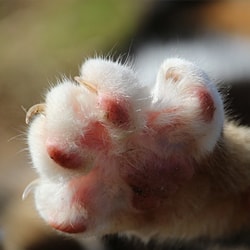CLAW DISORDERS IN CATS
Claw disorders in cats (symptoms, causes, treatment, follow-up care).
 Claw — a curved, horny appendage at the end of cat’s toes. Cats have five toes on the front legs, but only four at the rear. Claws on the front legs are covered with the folds of skin. Usually cats are hiding their claws, and only release them when needed. But when the cat is old, or has developed a claw disorder, they find it difficult to keep the claws in a hidden form.
Claw — a curved, horny appendage at the end of cat’s toes. Cats have five toes on the front legs, but only four at the rear. Claws on the front legs are covered with the folds of skin. Usually cats are hiding their claws, and only release them when needed. But when the cat is old, or has developed a claw disorder, they find it difficult to keep the claws in a hidden form.
Symptoms of claw disorder in cats:
Most often the cats are disturbed by a broken claws, or when they are simply too long. And symptoms of such issue are visible to the naked eye. But sometimes there are claw diseases with no obvious symptoms, and the only sign that there is something wrong — the cat is limping, or doesn’t let you touch its paws.
Causes of claw disorder in cats:
Claws (just like human nails) are constantly growing, and if a cat doesn’t grind them sufficiently — they become too long, and start to cause problems. Normally, if a cat spends enough time outside, climbing trees, it will wear out the claws, grinding them down naturally. Domestic cats can grind their nails on the front legs on special tools, or furniture, and hind legs — during games involving active movement.
Cat’s claws will grow too long very quickly, if it leads a sedentary life, or doesn’t have proper conditions to grind them.
Some owners punish their cat for sharpening its claws on the furniture or doorways etc, but don’t buy special grinding tools. This will inevitably lead to a health issues for the cat.
How dire are the consequences:
Very long claws prevent an active lifestyle. Cats can’t properly walk, climb trees, etc. But very long claws can even be a cause for much bigger injuries, such as sprains.
When the claws grow too long, they might start bending and grow into the pads of the paw, leading to infections, not to mention that it will cause severe pain for the cat.
When the claw is damaged, the soft tissue around it will quickly become infected if not treated.
What should you do:
- If a cat has too long claws.
If you find that your cat’s claws are too long, ask a veterinarian or a groomer to inspect the cat. Should they see it as a problem, they can immediately trim the claws.
If your cat is unable to properly «maintain» the claws on its own (they grow too fast or doesn’t have proper conditions), you should ask a professional to teach you how to trim them and regularly do it by yourself.
- If a cat has a broken claw.
If the tip of the claw has cracked, but didn’t come off, and you don’t see anything else that could require a professional help (no blood, claw and the nearby tissue doesn’t look infected), you can simply cut it off. Cutting of the tip of the claw is painless for a cat, but you might want to restrain it anyway.
If the claw is severely damaged, and bleeding — gently bandage a cat’s paw and immediately seek the help of a veterinarian.
Treatment of injured or infected claw:
In cases where the claw is severely damaged, the veterinary surgeon will remove the damaged piece or the entire nail (it depends on the degree of damage). If the surrounding soft tissue developed an infection, then the course of antibiotics will most likely be prescribed.
Aftercare:
Try not to let a cat go outside for several days. Either you or a veterinarian will have to change the bandage on the paw every few days or when\if it gets dirty.
Prevention:
Check your cat’s claws regularly. Give your cat an opportunity to naturally grind down its claws, if such option is not available — consider purchasing special claws grinding tool for cats, and learn how to trim the claws.